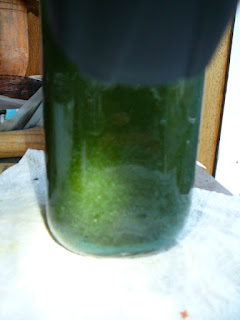Woad pigment was used in the Book of Kells. I wasn't too surprised. Woad was used for blue dye since, well, prehistory probably. It is said Celts tattooed themselves blue or painted themselves blue with woad. But this is now being called into question for many reasons. However, anyone who has used a woad vat would notice a blue scum does collect at the top and it seems perfectly plausible this could be used as a simple pigment.
Extracting indigo pigment from woad turns out to be much simpler than dying with a woad vat. With a healthy plants, good soil and the right equipment, you can process and wash indigo pigment in a handful of hours.
First the fresh first year leaves(*) are picked and thrown into boiling water. As soon as they are all in, I turned the heat off. There is a fine balance between hot enough to extract but too hot and damaging indigo precursors. I took it off the heat, put a tight lid on, and moved the pot to cool on bricks outside of the house.
Once it's cool enough to handle(a couple hours or more), I squeezed the faded spent leaves, and strained the liquid. It should be a lovely warm russet reddish brown. This is full of indigo precursors. Now some people use beaters or pour the liquid back and forth between containers, or a blender. Personally, I have things to do so I go strait for the Vitamix.
Pour the whole thing in, add a teaspoon or more of soda ash, and mix.
Use the lowest speed for a couple of seconds, until everything is mixing around, then take it up a quarter until you have a nice vroom and everything is getting frothy. Don't go too high or too long, or the indigo will all land on the top of the foam and take forever to settle. When you see spots of blue on the top of the foam...no more that 15 to 20 seconds...you're done.
You will be able to see the indigo falling to the bottom, in the dark greenish blue liquid as "swirlings", but it'll be too dark to see the pure blue until it's washed.
Let it sit for half and hour to and hour, however long it takes for the liquid to settle and most of the foam to disappear.
Now you have to be careful. The liquid is too dark to clearly see the indigo sitting at the bottom, though you may see some if you shine and very bright torch right up against the glass. Because you can't see it, you have to CAREFULLY and SLOWLY pour half the liquid out(you can save this to lake if you want to). If you fumble, you have to put it down and let it settle again. The indigo is so fine, once disturbed it is float freely, happy to escape down the drain! Once you get practiced you have a good idea how far you can go.
Now add clean cold water to the jar filling it up, and let it settle again. At this point you can barely see the slightly darker mass at the very bottom. Usually no more than a quarter inch unless you have very healthy plants. Repeat the process.
Now the liquid is a medium transparent green and the indigo is clearly visible. Depending on technical skill and fine motor control, you can cut down your washing time significantly once you have an idea of how fast you can pour without losing indigo or cause backwash. Once the water in the large container is a very pale green tint, you can transfer the indigo to a smaller container to wash.
You want to wash it until the water is clear and the indigo is a deep dark blue. It will be the bluest natural blue you have ever seen, like a deep lake under a clear sky.
Once the water is clear, then it needs to be poured and siphoned off. Turkey basters and pipettes help. When the indigo is in a small container with only an eighth inch of water, then it can be poured onto a glass plate or other non reactive flat surface to dry.
Indigo is supposed to produce, once ground with binders and water a dark navy blue, not as spectacular as the deep blue dye. But at least it's blue.
*Most sources insist one use first year leaves. But my plants are deciding they are perennials...after flowering, they put out new leaves from the roots and they are the same quality as "first year leaves". They should be soft, slightly hairy, green with the purplish stalk. I don't know why my plants are deciding to be immortals, but I'm not arguing as long as they keep the blue coming.






No comments:
Post a Comment
Note: Only a member of this blog may post a comment.